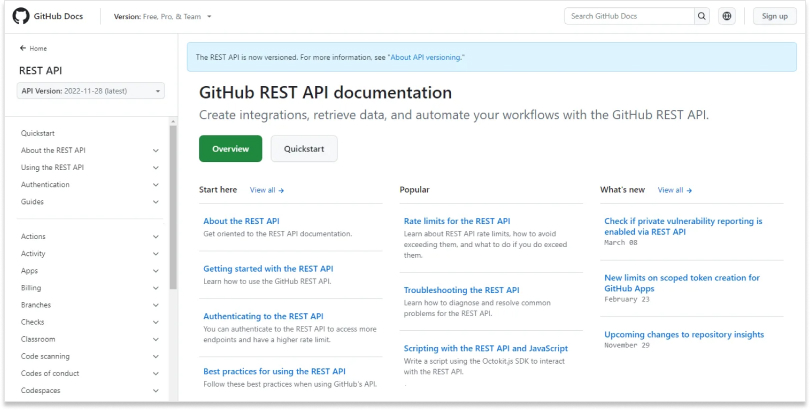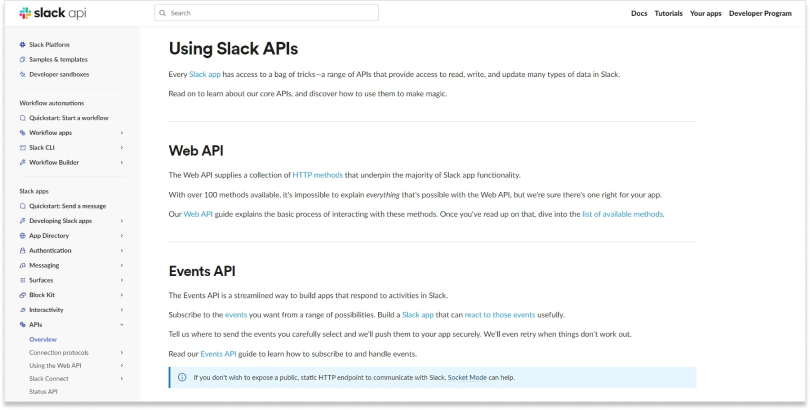In the realm of software, APIs (Application Programming Interfaces) serve to connect different programs seamlessly. Writing clear and precise guides for these APIs is an absolute necessity. It helps developers understand how to properly use an API without getting stuck.
Imagine you just bought a new gadget with a handbook telling you how to set it up and use it. That handbook is exactly what we’re talking about when we say API documentation. As more APIs are being developed, knowing how to write good API documentation is becoming an essential skill.
Contents
This guide will help you make your API easy to comprehend and use. Regardless if you’re sharing your API with everyone or just among your team members, we’ll help you make your documentation helpful and easy to follow.
What is API Documentation?
Let’s start with the API definition.
An Application Programming Interface technical documentation serves as much more than a simple user manual; it’s the cornerstone for successful software development and integration. It offers developers a comprehensive guide on using and integrating with an API by outlining specifications for routines, data structures, object classes, variables, code samples, etc.
Essentially, these docs are highly detailed maps guiding developers through connecting with the API. They clearly explain which calls are necessary while highlighting expected responses and data exchange formats.
Reliable and accurate documentation goes above basic functionality so developers can implement the API smoothly – ultimately enhancing efficiency and productivity.
Let’s look at Google Maps’ API documentation as an example: its clarity, structure, and practical examples have led to its widespread adoption and integration into countless applications worldwide.
Comprehensive API documentation is one of the top factors in deciding whether or not developers want to use an API. This underscores how crucial thoroughness is in all steps, from exploring the possibility of using the software all the way down to designing solutions with it in mind.
Importance of Well-Written API Documentation
Well-written API documentation’s value far surpasses a mere reference tool; it’s a critical asset that simplifies the developer experience, streamlines development processes and supports successful API utilization.
This high-tier documentation is a self-service hub, helping developers troubleshoot independently, understand the API’s capabilities, and construct effective solutions. Allowing them to navigate these processes easily quickens the development cycle and drives innovation by giving developers space to explore and experiment with functionalities.
Take Slack’s API documentation, for example: it is often praised for being comprehensive and user-friendly. Users can quickly find what they need, allowing them to integrate Slack’s many features into various workflows and products at exceptional speeds. That level of detail considerably reduces direct support needs – allowing your team to be more productive in other aspects.
Investing time into creating and maintaining such quality API documentation is more than just making life easier for users – it’s about building a solid foundation for your software to grow. The more precise you are now at this stage, the more extensive community you’ll make that will help each other create innovative solutions down the line.
Who writes API documentation?
-
1. Technical Writers
Experts at creating technical content, these writers can take difficult-to-understand information and present it clearly and user-friendly for developers to follow.
-
2. Developers
People who write API documentation usually know a lot about the design and function of the API they’re writing about. This is important because this knowledge makes it easier to describe some of the more complex parts of the API and ensures that all the documentation is correct and comprehensive.
-
3. Product Managers
Product managers handle both planning and execution, ensuring that all is in line with your product strategy while meeting users’ needs. Regarding API docs, PMs are crucial in determining what to focus on.
-
4. Quality Assurance Engineers
QA engineers play a vital role when it comes to the API. They check for any inconsistencies, errors, or omissions in the documentation. Their contribution is significant because they ensure that the accuracy and reliability of the document are maintained.
How to Write Good API Documentation
Creating good API documentation is critical when integrating developers with your platform.
Here’s how to create API documentation that stands out:
Start with the Basics
Have an overview of what it does and highlight its key benefits (an elevator pitch). This will give developers a quick understanding of whether or not their needs align with your offering.
Use Clear Examples
Have an overview of what it does and highlight its key benefits (an elevator pitch). This will give developers a quick understanding of whether or not their needs align with your offering.
Keep It Organized
Examples are the most essential part of good API documentation. They help you see the steps in making an API call. This includes the format, required parameters, and even how to respond with an example. These examples can be seen as something practical, much like a cookbook that doesn’t just list ingredients but also shows cooking instructions.
Be Consistent
Structure is everything; having proper sections such as an introduction, quick start guide, detailed API endpoints, authentication methods, error codes, and FAQs will pay off when navigating through different sections becomes seamless.
Update Regularly
Updates are crucial to ensuring that your API remains relevant. Users will notice any inconsistencies or outdated information within your documentation, so keeping things fresh is always a good idea.
Detail Error Handling
Take the time to explain all possible errors that can occur, what they mean, and how to fix them. Understanding how bugs work is crucial for developers to find and fix issues efficiently. You can also include tips on how to troubleshoot problems.
Engage with Examples and Tutorials
Don’t just stick with the same bland call-and-response examples: those are an absolute snooze-fest. Instead, pull out all the stops: create tutorials and walkthroughs to help developers with common workflows and complex operations. When users can see your API in action for themselves, they’ll be more inclined to use it.
Incorporate Feedback
As we’ve mentioned already, user feedback is a gold mine. It’s your secret weapon to crafting perfect documentation all around. So, wherever you can, open channels to let users share their thoughts. Whether through comments, forums, or direct contact options, make sure the lines of communication are always open. That way, you’ll be able to identify any gaps, unclear sections, or areas for improvement.
API Documentation Best Practices
Think about these best practices when it comes to designing your API documentation so that it can stand out and actually be effective.
Interactive Examples. With interactive examples, users can see what happens when they document API calls and integrate them. This approach enhances learning so they’ll know how to do this themselves next time. Platforms like Swagger UI are beneficial because they enable hands-on learning by letting users write their API requests for real-time responses. Interactive documentation is a must in API design documentation.
Accessibility. Make sure that your API document is understandable for all kinds of developers across the board: whether they’re beginners or experts. Explain technical terms and use straightforward language to make the information more inclusive. User-friendly content will meet web accessibility standards, which will only further show potential users your dedication to them.
Feedback Mechanisms. By embedding feedback options into your own documentation, you’re giving users an easy way to suggest improvements or report issues directly within the document itself. The feedback loop created by this feature helps improve future versions of the document over time: keeping them relevant, accurate, and user-centric throughout its lifespan.
Security and Authentication. The process for security and authentication should be wholly detailed regarding endpoint documentation—users should have clear instructions on securing their own API calls, managing their keys, and implementing OAuth flow right from the get-go with no guesswork involved. Your guidance will help developers secure their integrations while immediately showing that your resource is trustworthy. So, don’t skip it!
Versioning Information. Precise versioning information in your API design document helps developers navigate updates and changes later on down the line. As you update different aspects of your design doc, provide detailed changelogs in tandem with migration guides so that everyone stays on the same page during the development stages and after all the releases have been made. Smooth transitions between API versions will show developers that they can maintain compatibility and adapt to new features with minimal disruption—saving everyone a ton of headaches in the long run.
REST API Documentation Examples
To provide you with some real-time inspiration around creating your own informative, user-friendly documentation, let’s take a look at some different API documentation examples out there.
These examples will give you an up-close understanding of how interactive examples, clear organization, comprehensive security guidelines, and regular updates are all seamlessly woven into one resource.
Interactive API Explorer
The ability to make live API calls directly from within your API design document is an amazing feature for developers who often need to troubleshoot or quickly test things on the fly. And it’s something that you should be doing too!
For example, Stripe’s API documentation lets users run their own API queries from within the document. Users’ queries then display responses in real-time, so they don’t have to leave the doc ever! This makes it super easy for them to learn how to do this themselves, which separates good interactive documentation from inadequate static documentation at a foundational level.
Clear, Organized Structure
One of the most critical features of any kind of documentation is fast accessibility. If people can’t navigate through your information quickly and easily, they’re just going to exit completely.
To prevent this, make sure that all your content is split into logical sections and subsections like Overview, Authentication, Endpoints, etc. In other words, everything needs to be broken down into smaller “chunks” so people can digest it better. On top of this, each section must also have clear headings and subheadings, as well as a search function for quick finds.
Twilio’s API documentation provides a great example of how to write good API documentation with its well-organized and easily searchable content.
Detailed Authentication Guidelines
Safety always comes first when integrating an API. Listing the steps and any keys or tokens developers need to connect your API is a great way to ensure secure connectivity.
The guiding information provided by GitHub’s REST API documentation is one of the API documentation standards because it includes several different authentication methods that can be utilized when users need them the most.
Inclusive Error Handling
Creating a section specifically about error responses and troubleshooting can go a long way in giving developers a good experience.
Examples like Slack API’s detailed error codes, explanations, and solutions show how good comprehensive API design documentation looks.
Tools for Creating API Documentation
When it comes to making API documentation, things can get pretty confusing. But don’t worry; there are API documentation tools specifically designed to make this process easier.
These tools automate part of the excellent API documentation process and provide interactive features for a better user experience.
1. Swagger (OpenAPI)
Swagger is a widely used framework that lets people design, test, build, and document RESTful APIs. It has three main components: the Swagger Editor for writing APIs specifications, the Swagger UI for generating dynamic documentation from these specs, and Swagger Codegen, which generates server stubs and client libraries from an OpenAPI Specification (OAS). All in all, its interactive interface makes understanding your API much more effortless.
2. Postman
Postman was initially created as an API testing tool but also offers a feature to document APIs. With this tool, you can generate beautiful machine-readable docs from collections that show you how to document APIs effectively. You’ll see that running API calls directly on the page enhances learning and testing.
3. ReadMe
ReadMe allows you to create visually appealing interactive docs easily. Their focus is on engaging end users by providing examples that are not only clear and comprehensive but also engaging for the end-user. Features include customizable pages, interactive API Explorer, and direct feedback options from developers, so you know what needs improvement.
4. Docusaurus
Docusaurus is a project for building open-source websites quickly with automated deployments and continuous integration workflows. It’s not specifically built to create API endpoint documentation but can be used correctly. Docusaurus supports Markdown and includes features like document versioning, search functionality, support for custom plugins, etc.
5. Slate
Slate makes creating intelligent, responsive API documentation easy… well, at least aesthetically pleasing! With its slick design capabilities, you can tailor your API design document to your API’s needs, making your documentation look great.
Conclusion
An effective API specification document is not just about listing endpoints and methods. It’s about creating a comprehensive guide that empowers developers to use your API easily.
With the best practices for high-quality API documentation outlined in this guide, you can do just that: provide interactive examples, ensure accessibility, incorporate feedback mechanisms, detail security protocols, and keep your documentation up-to-date. This way, you’ll create a valuable resource that enhances the developer experience and fosters a positive community around your API.
Remember, good documentation for APIs is always a work in progress. As long as you update it alongside your API, it will reflect changes and improvements and satisfy your user base. So keep investing in high-quality documentation because it’s an investment in the success of your API and the developers who use it.
For more insights on API development, consider exploring additional resources like Devcom’s API development services. Their team specializes in creating robust APIs for modern software applications and understands the importance of comprehensive documentation in ensuring seamless integration and adoption.














